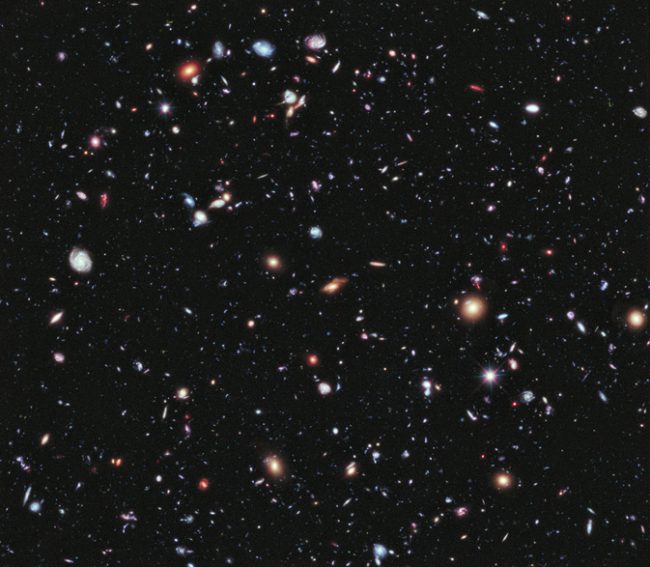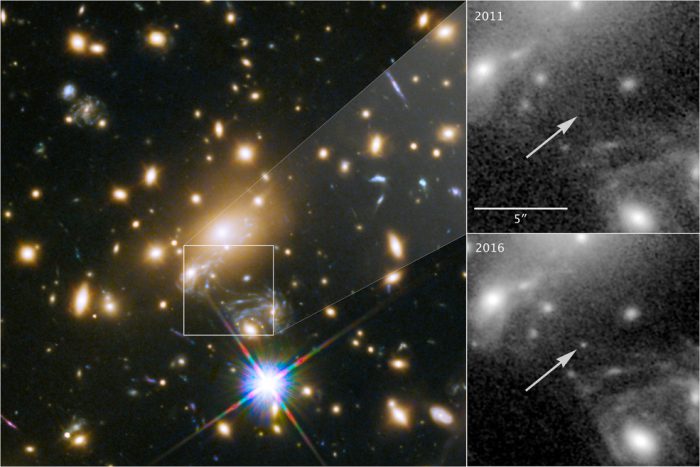Pop quiz: What is the most powerful telescope known?
Is it the Hobby-Eberly at the McDonald Observatory in Texas, with its incredible 10-metre (30-foot) wide aperture to collect light from the stars?
Or what about the famous Hubble Space telescope, orbiting high above us all, collecting data from far beyond our own world?
Those two are certainly high up the list. But they've got nothing on the top spot: the gravity of a galaxy cluster. Thanks to this unreal trick of interstellar nature, astronomers have observed Icarus—at 9 billion light years away, it is the most distant individual star ever seen! (You can see the farthest star ever at the top of this post—just follow the arrow!)
Why is this so significant?

Released in 2012, the eXtreme Deep Field photo combines 10 years of images collected by the Hubble to see 10 to 13.2 billion light years into the universe. (NASA; ESA; G. Illingworth, D. Magee, and P. Oesch, University of California, Santa Cruz; R. Bouwens, Leiden University; and the HUDF09 Team)
We've actually seen even farther into deep space than this before. The image above is known as the eXtreme Deep Field (XDP). Taken by the Hubble, it looks out up to 13.2 billion light years into the universe. So why is Icarus causing people to freak out?
Take a look at the XDP again. Every single object in it—even the tiniest point of light—is a full galaxy. Pick anything up there, and you're looking at billions of stars like our own, spinning together around a supermassive black hole.
Now go back to Icarus. It's just one lonesome star shining. It's not going ka-blooey in some huge supernova. It's not too different from our own Sun. It's light took 9 billion years to reach us ... and there it is. Hi there, little guy!
And seriously, how does that work??
All of that brings us to the truly mind-blowing part of all of this: How did astronomers get such an impossible picture? And what's this about gravity acting like a telescope? To get this picture, astronomers used something called gravitational lensing. This picture will help ...

Released in 2012, the eXtreme Deep Field photo combines 10 years of images collected by the Hubble to see 10 to 13.2 billion light years into the universe. (NASA/ESA)
This is an Einstein ring. It happens when super-powerful gravitational fields (from galaxies or black holes) distort light traveling through space. Here, it's actually making a kind of happy face. Cute!
But the stars inside that circle of light are also being magnified by the gravity. It creates a lens that makes distant images appear billions of light years closer than they are. That's basically how we saw the farthest star ever seen. By using the mighty gravitational fields that are already out there, astronomers can peer deep into the history of the universe.
 In the main colour image, Icarus is nowhere to be seen. It is only after it is magnified by the gravity of a nearby galaxy cluster that this star—9 billion light years from Earth—can be seen (bottom right image). (NASA, ESA, and P. Kelly—University of Minnesota)
In the main colour image, Icarus is nowhere to be seen. It is only after it is magnified by the gravity of a nearby galaxy cluster that this star—9 billion light years from Earth—can be seen (bottom right image). (NASA, ESA, and P. Kelly—University of Minnesota)










SUPER COOL!!!!!!! 😀
super Awesome !!!
Thanks I Love this magazine.✋
🙂 🙂 🙂 🙂 🙂 🙂 🙂 🙂 i love it is a fake email
from justin beaver
That’s soooooooooooooooooooooooooooooooooooooo. Coooooool??????????????⭐️?⭐️?⭐️⭐️⭐️⭐️⭐️⭐️⭐️⭐️⭐️⭐️⭐️⭐️⭐️??????????????⭐️???????????⭐️⭐️⭐️⭐️⭐️????????????????????????????????⭐️⭐️⭐️⭐️???⭐️⭐️??✨✨✨✨?⭐️?????⭐️?✨????⭐️???????⭐️⭐️⭐️⭐️⭐️⭐️⭐️⭐️⭐️⭐️⭐️⭐️⭐️⭐️???????????????????????????????????????????????????????⭐️⭐️⭐️⭐️⭐️⭐️⭐️⭐️⭐️⭐️⭐️??⭐️⭐️⭐️⭐️⭐️⭐️⭐️⭐️⭐️⭐️??⭐️⭐️???????????????????????